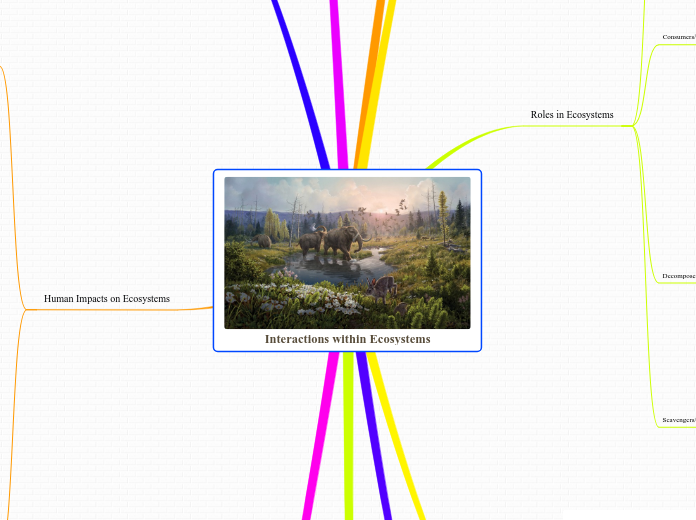av Zara Mollett 2 år siden
383
Interactions within Ecosystems

av Zara Mollett 2 år siden
383

Mer som dette
Firstly, make an inventory of the things you already have in your room.
Secondly, close your eyes and imagine your ideal room. Write down the changes you will make to create the room of your dreams.
Redecorating your room is easy and fun!
Secondary Succession is Primary Succession for the second time as the name suggests. It is when the previous ecosystem was destroyed and the plants grow back for the second time. For example, if a forest fire destroys a forest, the plants will have to grow back for the second time, sometimes humans would actually help with this process by planting trees in that area.
Primary succession is the growth of organisms for the first time. For example, when volcanoes erupt and the matter falls into the water, it will slowly grow an island. After the island is created, plants will start to grow and this is primary succession since this is the first time there has been life.
Overfishing
Overfishing is the poaching of fish. As the demand for food rises, fish is an easy source, but people are overdoing it. They are fishing too many fish causing species to go extinct. There are many more negative effects too. They also fish up dolphins, small sharks, and other animals, killing them. It also destroys underwater plants and coral reefs, and there are many more negative effects.
Poaching
Poaching, in other words overhunting, is the main cause of extinction and endangerment. It is when humans overhunt species and can cause the population to decrease. Sources say that over 30,000 species are driven to extinction annually because of poaching.
Overharvesting
Humans overharvest plants and food a lot because of the growing population and the growing demand for food. This threatens the extinction of plant species and can heavily impact their population.
Invasive species are animals and plants that are brought to an area that they didn't originate from. Being in a new environment changes the ecosystem there, and usually, invasive species cause many negative effects in nature.
Land Pollution
Land pollution is when trash ends up in landfills and pollutes the ground. 2.01 billion tonnes of trash is generated each year, and about a third of that goes to landfills and takes years to decompose.
Air Pollution
Combustion gasses pollute the air with smoke and decrease the quality of the air that we breathe. When we breathe this we heighten our risk for many lung illnesses.
Water Pollution
Oil spills, plastics, fecal waste, and many more are all examples of water pollution caused by humans. They all greatly impact aquatic ecosystems by making the conditions of the water unlivable for marine species.
Wildfires
Sources state that 85% of wildfires are caused by humans. This could be caused by arson, campfires, smoking, and more. This burns and destroys many ecosystems and ruins their habitats.
Deforestation
Humans have the need for wood to build homes, fuel fires, and more. To get wood they must chop down countless amounts of trees, destroying animals' and plants' habitats.
In the past 150 years, carbon rates in our atmosphere have gone up by 30% because of all the human activity that emits carbon, mainly combustion. Photosynthesis can not keep up with these high carbon rates. This is what causes the greenhouse effect, which is what causes climate change and the climate crisis.
Which are the things from the wardrobe?
Example: clothes, socks, shoes etc.
Humans protect endangered species and plants from predators. They also try to prevent other humans from negatively impacting ecosystems.
Humans plants lots of trees that boost the enviroment. They also replant trees after wildfires.
Humans recycle lots of materials preventing some waste from ending up in landfills and damaging our planet.
Run-off
The water goes back on the ground, and the cycle repeats.
Precipitation
Water falls down in the form of rain.
Condensation
Water vapor condensates into clouds.
Evaporation
Water on the ground evaporates into water vapor.
What kind of pet do you have in your room?
What is your pet's name?
Respiration
When animals and humans breathe, we breathe in oxygen and breathe out carbon dioxide. This brings a lot of carbon into the atmosphere.
Death & Decomposition
When plants/animals die, their bodies incorporate into the soil and might turn into fossil fuels which bring on more combustion. Overall, this brings carbon into the world.
Photosynthesis
Photosynthesis is when plants take carbon dioxide from the atmosphere and convert it into oxygen. This removes carbon from the atmosphere.
Combustion
Combustion is when matter is burned and the fumes go into the air, this emits carbon dioxide into the atmosphere.
What do you want to change in your room?
When do you want to do that?
Waste and Heat Loss - 60%
Life Functions - 30%
Big Ways
Installing solar panels and use that as your electricity source for your house
Buy an electronic car (Tesla)
Small Ways
Reduce, Reuse and Recycle
Ensure that the products you buy are eco-friendly
Buying organic groceries
Using reusable shopping bags and water bottles
The Eastern Grey Squirrel is native to North America and was brought to Europe by an Italian diplomat, in 1948. They cause numerous types of damage. They strip bark from trees and steal food from other species. Most importantly, they kill red squirrels (that are native to Europe) with a disease they carry called "Parapox".
Omnivores eat plants and animals. Example: Bear, Human (Excluding vegans/vegetarians)
Carnivores eat other animals. Example: Lion, Hyena
Herbivores eat plants. Example: Giraffe, Cow
Which are the things that are placed on the ceiling?
Examples: ceiling lamp, phosphorescent sticky stars etc.
Which are the things that are placed on the shelves?
Examples: books, decorations, flower vases, photos etc.
Which are the things that are hanging on the walls?
Examples: paintings, clock, posters, mirrors etc.